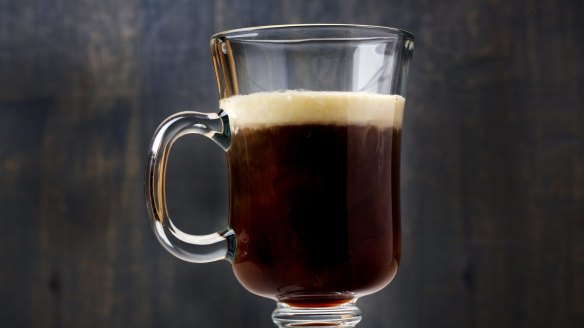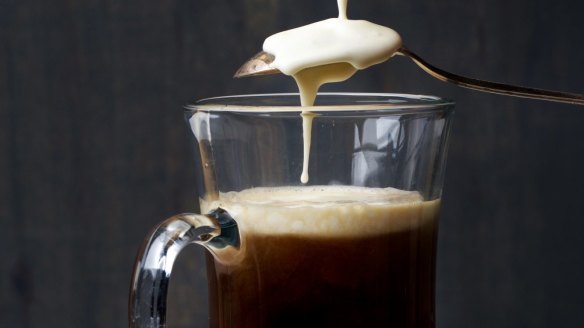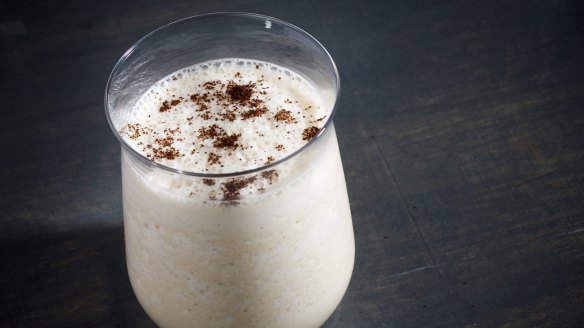How to make the perfect Irish coffee

Years ago, I had the fortune to be in Dublin on St Patrick's Day. I spent the day as any lit major with an Irish Catholic heritage and an interest in history would: visiting the worlds of Yeats, Wilde and Joyce, and exploring sites related to the complexities of the Republican cause and the "still indomitable Irishry" Yeats wrote of.
I trust readers will understand that by "visiting the worlds of writers and exploring sites of the Republican cause", I mean I mostly spent it pub-crawling.
I wasn't a beer drinker at the time, so over the course of the day I sucked down about seven Irish coffees.
Late in the evening, after hours of jigging and reeling to a local band at the last of a string of pubs, I confessed to my beer-sozzled friends that in this day-long application of whiskey, sugar, coffee and cream, the caffeine had proved victorious: I was stone-cold sober and possibly permanently awake.
The combination of hyper-caffeination and my own social awkwardness meant that, while others in my party were dancing and flirting with a charming global lineup of giddy young people, I was sober enough to focus on what I was drinking, noting differences between one pub's Irish coffee and the next.
The majority were pretty godawful, suffering primarily from the realities of the bar coffee, which had probably sat on a burner for hours, developing unlovely scorched notes that weren't drowned out by sugar or booze.
Made well, an Irish coffee is a thing of beauty. It perfectly suits the often damp and chilly weather of the country it's named for.
My recollection was largely confirmed by Sean Muldoon, managing partner at the Dead Rabbit Grocery and Grog in New York, an Irish bar that repeatedly turns up on lists of the best bars in the world. "The Irish coffees served in Ireland are typically not good," Muldoon told me via email. "I've tried hundreds and haven't had a good one yet." This, he says, is because Irish bars don't really take the drink seriously.
They tend to roll their eyes over it, confirms Kevin Hurley, global brand ambassador for Teeling Whiskey.
Which is a pity, because Irish coffee is the only cocktail on the International Bartenders Association drinks list - a roster of standards that any bartender should know - that specifically calls for Irish whiskey. Yet it's "one of those Irish anomalies that's far more popular in the States than it is in Ireland," Hurley says.
Historical roots
There's plenty of blarney around the history of cocktails in general, and the Irish coffee is no exception. The most well-known origin story is that it was born in the 1940s, when a bartender at the Foynes airport in County Limerick served it to passengers who had disembarked half-frozen from a seaplane that had turned back due to bad weather. One of the passengers asked whether the delicious libation was Brazilian coffee, and the bartender replied, "No, that's Irish coffee."
It's a story Don Draper could be proud of, but there are contradictory ones, including the possibility (raised almost offhand in the writings of Harvard historian John Kelleher) that the drink was invented by Michael Nugent, proprietor of the Dolphin Hotel in Dublin, to conceal the taste of bad coffee.
The drink purportedly crossed the pond in 1952 via travel writer Stanton Delaplane, who helped re-create it for the Buena Vista Cafe in San Francisco, which nurtured the drink with more tenderness than it had been shown in its home country. It still serves and celebrates the Irish coffee today. "If it wasn't for the Buena Vista, I don't know that it would have survived," Hurley says.
Made well, an Irish coffee is a thing of beauty. It perfectly suits the often damp and chilly weather of the country it's named for, as well as the contemplative and happily convivial feeling conveyed by a good Irish pub late in the afternoon as the shadows are lengthening and the day is slipping away.
A balanced brew
The Dead Rabbit, Muldoon says, serves between 50 and 250 Irish coffees a day; it's the bar's most popular drink. The bar has long made a great Irish coffee, but the version it serves now is a revision concocted a year ago with the help of renowned bartender Dale DeGroff.
Fitting, because it was DeGroff who inspired Muldoon to give the drink a serious look. During a seminar years back, DeGroff queried the crowd as to how many of them had ever had an Irish coffee. "Of course everybody in the audience raised their hands," Muldoon said. But when DeGroff went on to ask how many had had one that they actually liked, "not a single hand was raised".
DeGroff explained that most bartenders treated the drink as an afterthought, and that as a result the coffee was often burned, the cream sprayed from a can, the ratio of sugar to coffee to whiskey off. He went on to lay out some key principles: Always use freshly made coffee (never espresso); use a light-style, high-grain-content whiskey (so that none of the drink components will overwhelm the others), a rich demerara syrup, and fresh cream whipped by hand and kept cold till use.
The Dead Rabbit's recipe is the best version I've had: a balanced, richly bittersweet brew topped with pillowy, snow-white cream that, when whipped properly, stays separate, floating like sea-foam atop the drink. With its pale head of cream, the cocktail ends up visually echoing that other Irish delight, a perfectly poured Guinness.
A cool twist for warmer climates
In places where the climate is less Irish (a roster that, given global warming, may one day include Ireland itself), a hot coffee cocktail is not always so welcome. But in the French Quarter of New Orleans, Irish bar Erin Rose sells what must be the most beloved non-traditional "Irish coffee" around.
It's frozen, and that's not the most untraditional thing about it: There's no Irish whiskey in the base recipe. The booze is a blend of brandy and coffee liqueur. (Bartender and manager Rhiannon Enlil doesn't know the backstory of how the drink was developed but says customers often compensate by adding an Irish whiskey floater.)
I'm not sure a drink without Irish whiskey in it should really be called "Irish", but having sucked down the awakening relief of Erin Rose's frozen Irish coffees during the heat of midsummer nights in New Orleans, I'm a rabid fan.
What's more, in its self-appointed indomitable Irishry, it shares something with many celebrants of St Patrick's Day, who hail the Irish diaspora by sportin' a bit o' the green even if their own genetic makeup doesn't sport a lick of the Irish. Sure, you could argue it's just an excuse to have a wee dram, but I wish we had such a celebratory approach to more immigrant groups. If everyone (including a cocktail based on French brandy and Mexican-coffee liqueur) wants to be Irish on St Paddy's Day, so be it. Rather than ordering a DNA test and calling the cocktail authenticity cops, I think I'll have a drink.

Irish coffee recipe
2 servings
A classic warmer, this version from the world-renowned Dead Rabbit Grocery and Grog, a wonderful Irish bar in New York, was adapted from legendary bartender Dale DeGroff.
You'll need two 20-centimetre glass-stemmed (heatproof) mugs.
MAKE AHEAD: The demerara syrup can be refrigerated for up to 1 week. You may not use all the cream; the amount given below makes it easy to whip.
Ingredients
½ cup heavy cream (see headnote)
240ml brewed hot coffee (the Dead Rabbit uses Sumatra Mandheling)
30ml rich demerara sugar syrup (see note below)
90ml premium Irish whiskey
Method
Whip the cream in a container with a pouring spout until it's slightly fluffy yet still pourable.
Combine the coffee, syrup and whiskey in a pitcher, stirring until well incorporated. Divide evenly between the mugs. Working with one at a time, pour the whipped cream gently onto the back of a spoon held directly over each mug, letting the cream cascade onto the surface of the coffee until that layer is no thicker than 1⅓ centimetres.
Serve right away.
NOTE: To make the rich demerara syrup, combine 2 cups demerara sugar and 1 cup water in a saucepan over medium heat, stirring until the sugar has dissolved. Cook for 2 minutes, then remove from the heat and cool completely. Transfer to an airtight container; chill until ready to use (up to 1 week).

Frozen 'Irish coffee' recipe
2 servings (makes about 3 cups)
The classic Irish coffee is pumped up with whiskey and served hot to warm up cold Gaelic afternoons.
At the Erin Rose bar in New Orleans's French Quarter, the drink has been adapted for the climate. While the recipe is a house secret, the bar provided a few pointers - one of which is that its version is made with brandy instead of Irish whiskey. Make and chill the coffee ahead of time.
You'll need a blender; you may wish to serve the drinks with straws.
Ingredients
1/2 cup vanilla ice-cream
2 cups ice cubes
120ml brewed, chilled coffee
60ml brandy
60ml coffee liqueur, such as Tia Maria
¼ teaspoon coffee grounds, for garnish (optional)
Method
Combine the ice-cream, ice cubes, coffee, brandy and coffee liqueur in a blender. Puree on HIGH until the ice is completely broken down and the mixture is the consistency of a milkshake.
Divide between two highball glasses, then sprinkle a pinch of coffee grounds, if using, over the top of each. Reserve any leftovers for topping off.